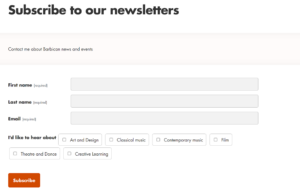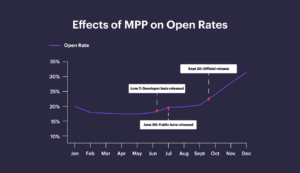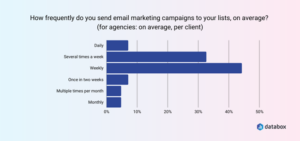
Beginner Read Digital Strategy
An effective digital strategy can be vital to your organisation’s success. Read on to understand the key considerations when developing yours.
In this article

Activity at MIMA, Photo © Judy Hume
When your email marketing campaign doesn’t perform as well as you need or as well as expected, there are some simple questions to ask. Using the 5 W’s, the basis of the classic police investigation, are a good place to start your investigation: Who, What, When Where, and Why?
The single most important factor in dictating whether your email campaign is going to be a success is who you are sending it to. 87% of the UK adult population have an active email address (quora.com), 99% of people check their inbox every day, and email is the best performing marketing channel so there is plenty of potential, but how does that relate to your business?
To get the most out of email marketing, it is best to play to the email’s strengths of targeting. Sometimes email marketing doesn’t work because your audience knowledge is incomplete, and you are trying to second guess what will be of interest to your subscribers.
If you have gaps in your knowledge of your audience, how could you set about gathering more information? Sometimes you can build a picture of behaviour and interests by tracking email responses over time. Many organisations now use surveys or preference centres (a page that allows your subscribers to control their email experience), which help to build a picture of their subscribers. Whenever you make contact with your subscribers it is a chance to gather more information.

To improve targeting, you need a good understanding of audience interest, engagement, and behaviour. Creating buyer personas can help you improve your targeting and better personalise messaging. Personas are composite sketches of segments of your audience or customer base and bring to life the people who are engaging with you. It is a way of more actively visualising your audience/customers, helping your strategy and marketing activity because you and your team can use them to understand motivations and anticipate needs in your marketing and communications more fully.
Another way to ensure that you are targeting the most-likely-to-respond customers, is to use RFV (recency, frequency, value). The most likely to respond profile of a segment is made up of the following:
If, for example, you have a family event with limited capacity, using RFV might be a way of further segmenting your data efficiently so that you don’t email the whole list, only to turn away people when you have reached capacity.
In the past, open rates were a key indicator of the success of an email campaign. With the introduction of Apple’s new Mail Privacy Protection (MPP) in September 2021, it is no longer possible to work out whether an email has been opened by a subscriber who has opted in to MPP as the system will report as if all subscribers to MPP have opened their emails. The consequence is that open rates have artificially increased with a knock-on effect on the click-to-open rate.

It is better to use the click rate which measures engagement in terms of your calls to action. Also, avoid using a snapshot to decide that there is a problem. A couple of recent unsuccessful campaigns in a row aren’t necessarily indicative of a problem. One way of getting a sense of the bigger picture is to look at benchmarks. Email Service Provider Campaign monitor used their platform data to publish some benchmarks by industry and Mailerlite and SmartInsights published a few benchmarks more directly related to the arts:
| Industry | Open rate | Click through rate (CTR) | Unsubscribe rate | Bounce rate |
| Art Gallery and Museums* | 45.7% | 5.6% | 0.3% | 0.3% |
| Arts and Artists* | 37.2% | 10.1% | 0.3% | 0.3% |
| Entertainment and Events* | 36.2% | 6.6% | 0.3% | 0.3% |
| Non-profits** | 31.7% | 3.4% | 0.1% | 2.4% |
Sources: *= Mailerlite; **=SmartInsights
If, however, you are experiencing a sustained drop in the performance of your emails over time, a quick health check of your emails could help you get back on track. A basic health check of your emails can help to diagnose easy to resolve problems:
If you think any of these aspects of your email might be worth looking at in more depth, you can find out more in our Health Check your Email Marketing article.
The difficulty with deciding how often to send emails is that it is business dependent. You need to be sending emails often enough to be in your audience’s mind, but not sending emails so often that you are struggling to find relevant content and your audience is reaching for the unsubscribe button.
One of the deciding factors sometimes comes down to resources: the more people involved in producing emails across the team, the greater the frequency of emails. If you are sending multiple emails a week to the same contacts, it is vital to have a schedule to ensure that you are not over-mailing and reducing your response rate by sending emails too closely together.

Sending relevant emails at the right time is why automations work. Email automation takes advantage of a particular point in the customer journey to send an email or sequence of emails that anticipate needs, provide relevant information, or increase engagement.
Automated emails create over 3 times more revenue than non-automated emails. (Campaign Monitor)
One of the most common automation is the Welcome email that is sent when an individual subscribes to a subscriber list. Customers are at their most receptive when they are new – they are expecting to hear from you and welcome emails can generate up to 91% open rate.

Royal Academy welcome email
For email marketing to be a success, emails must get through. Measuring deliverability tells you how many of your contacts received your emails and whether you managed to avoid ending up in a spam folder.
If your list is permission-based with individuals signing up expressing an interest in hearing from you, you are part of best practice. Double opt-in, establishing what use the contact data submitted is being put to, and what a new subscriber should expect on sign up, is also part of having best practice, and helps support deliverability. Creating a seed list, a circulation list of email addresses that you send emails to before you send them out to your subscribers can also help to highlight any issues with deliverability. Our email checklist is a good place to start and each Email Service Provider such as Mailchimp; Dotdigital; Constant Contact etc. have guidelines on how to ensure that your email account is set up correctly to maximise deliverability (Mailchimp; Dotdigital; Constant Contact).
In your investigation, there is always the ‘why’ question – the motivation behind any action or engagement. Putting yourself in the shoes of your customers is the best way to help you create emails that connect and engage your audience.
By establishing why your customer should buy your ticket, take part in your event, sign up to your list, or watch your video, you’ll be better placed to test whether your email is encouraging the desired behaviour, be that providing an incentive, upselling and cross-selling, re-engaging, or rewarding loyalty.
To maximise the response to your email marketing, make sure that the ‘why’ of you email campaigns has addressed the question that every contact asks themselves when they open you email: ‘What’s in it for me?’.
The Digital Culture Network is here to support you and your organisation. Our Tech Champions can provide free 1-2-1 support to all creative and cultural organisations and individuals who are in receipt of, or eligible for, Arts Council England funding. If you need help or would like to chat with us about any of the advice we have covered above, please get in touch. Sign up to our newsletter below and follow us on Twitter @ace_dcn for the latest updates.
Beginner Read Digital Strategy
An effective digital strategy can be vital to your organisation’s success. Read on to understand the key considerations when developing yours.
Beginner Read Email Marketing
Email marketing is a powerful tool when it comes to building relationships with your audience. Read on to find out more about what it can do for your organisation.
Beginner Read Video and Digital Content
Storytelling is the key to amazing content. Read on to understand how to incorporate great content into all facets of your digital marketing.
Beginner Read Email Marketing
Personas are fictional representations of people within your audience or customer base. In this article, we explore how personas work where resources in terms of time and budgets are limited. If you don’t have time or money for a major project, this article will show you what a lo-fi, low-cost version of personas look like and how can creating personas add value.
Beginner Read Email Marketing
Contact data is business critical and one of your organisation's most valuable assets. Find out how to set up and grow, and collect a contact database starting with these 5 essentials.
Beginner Read Email Marketing
Want to improve your email marketing? Our health check will help you asses and improve you activities.




